
A supercell is a thunderstorm characterized by the presence of a mesocyclone: a deep, persistently rotating updraft. Due to this, these storms are sometimes referred to as rotating thunderstorms. Of the four classifications of thunderstorms, supercells are the overall least common and have the potential to be the most severe. Supercells are often isolated from other thunderstorms, and can dominate the local weather up to 32 kilometres (20 mi) away. They tend to last 2–4 hours.

The 1985 United States–Canada tornado outbreak, referred to as the Barrie tornado outbreak in Canada, was a major tornado outbreak that occurred in Ohio, Pennsylvania, New York, and Ontario, on May 31, 1985. In all 44 tornadoes were counted including 14 in Ontario, Canada. It is the largest and most intense tornado outbreak ever to hit this region, and the worst tornado outbreak in Pennsylvania history in terms of deaths and destruction.

A funnel cloud is a funnel-shaped cloud of condensed water droplets, associated with a rotating column of wind and extending from the base of a cloud but not reaching the ground or a water surface. A funnel cloud is usually visible as a cone-shaped or needle like protuberance from the main cloud base. Funnel clouds form most frequently in association with supercell thunderstorms, and are often, but not always, a visual precursor to tornadoes. Funnel clouds are visual phenomena, these are not the vortex of wind itself.
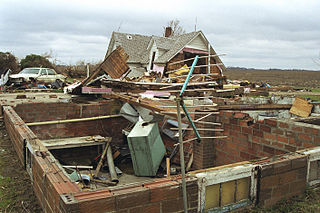
The 1998 Comfrey–St. Peter tornado outbreak was an unseasonably-strong tornado outbreak which affected the Upper Midwest region of the United States on March 29, 1998. A strong area of low pressure combined with a warm front and favorable upper-level dynamics to produce 16 tornadoes across the region—14 in Minnesota and two in Wisconsin. Thirteen of the tornadoes in Minnesota were spawned by a single supercell thunderstorm. This supercell remained intact for approximately 150 miles (240 km) as it moved across the southern part of the state during the late-afternoon hours.
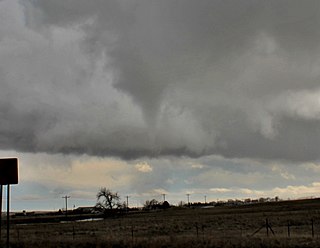
Tornadogenesis is the process by which a tornado forms. There are many types of tornadoes and these vary in methods of formation. Despite ongoing scientific study and high-profile research projects such as VORTEX, tornadogenesis is a volatile process and the intricacies of many of the mechanisms of tornado formation are still poorly understood.

This page documents notable tornadoes and tornado outbreaks worldwide in 2003. Strong and destructive tornadoes form most frequently in the United States, Bangladesh, and Eastern India, but they can occur almost anywhere under the right conditions. Tornadoes also develop occasionally in southern Canada during the Northern Hemisphere's summer and somewhat regularly at other times of the year across Europe, Asia, and Australia. Tornadic events are often accompanied with other forms of severe weather, including strong thunderstorms, strong winds, and hail.

The 2006 Westchester County tornado was the strongest and largest tornado in Westchester County, New York since the 1904 Chappaqua tornado. It touched down there on Wednesday, July 12, 2006, and traveled 13 miles (21 km) into southwestern Connecticut during a 33-minute span through two states. The tornado touched down at 3:30 p.m. EDT (19:30 UTC) on the shore of the Hudson River before becoming a waterspout and traveling 3 mi (5 km) across the river. Coming ashore, the tornado entered Westchester County and struck the town of Sleepy Hollow at F1 intensity. After passing through the town, it intensified into an F2 tornado and grew to almost a one-quarter mile (400 m) in diameter. The tornado continued through the county, damaging numerous structures, until it crossed into Connecticut at 4:01 p.m. EDT (20:01 UTC). Not long after entering the state, it dissipated in the town of Greenwich at 4:03 p.m. EDT (20:03 UTC). When the tornado entered Westchester County, it was the eighth known tornado to either touch down or enter the county since 1950.
The Southern Ontario Tornado Outbreak of 2009 was a series of severe thunderstorms that spawned numerous tornadoes in Southwestern Ontario, Central Ontario and the Greater Toronto Area (GTA) on August 20, 2009, and was the largest single-day tornado outbreak in Ontario history and the largest in Canadian history. During the afternoon and evening, 19 tornadoes touched down with four of them producing F2 damage. One F2 struck the town of Durham where significant damage occurred and one person was killed; two F2s struck the city of Vaughan, just north of Toronto, damaging hundreds of homes; another F2 devastated apple orchards and resort areas near Thornbury. The number of tornadoes associated with this event surpasses that of August 2, 2006, which saw 18 documented tornadoes. In addition, it was one of the most destructive and costly tornado events ever in the province, and included one fatality, one of only a handful of deadly tornadoes in Ontario's recent memory. At one point, over 10 million people in Southern Ontario, one-third of Canada's population, were placed under tornado watches and/or warnings as the storms rolled through.

A tornado outbreak struck southern and central Poland on 15 August 2008. Overall, it killed four people. Tornadoes affected Opole Voivodeship, Silesian Voivodeship and Łódź Voivodeship. The European Storm Forecast Experiment issued a Level 3 which means there could potentially be a major severe thunderstorm outbreak.
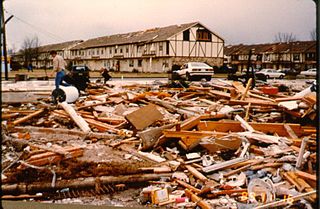
This page documents the tornadoes and tornado outbreaks of 1989, primarily in the United States. Most tornadoes form in the U.S., although some events may take place internationally. Tornado statistics for older years like this often appear significantly lower than modern years due to fewer reports or confirmed tornadoes.

This page documents the tornadoes and tornado outbreaks of 1990, primarily in the United States. Most tornadoes form in the U.S., although some events may take place internationally. Tornado statistics for older years like this often appear significantly lower than modern years due to fewer reports or confirmed tornadoes, however by the 1990s tornado statistics were coming closer to the numbers we see today.
The following is a glossary of tornado terms. It includes scientific as well as selected informal terminology.
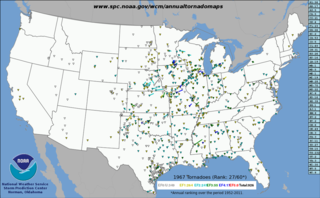
This page documents the tornadoes and tornado outbreaks of 1967, primarily in the United States. Most tornadoes form in the U.S., although some events may take place internationally. Tornado statistics for older years like this often appear significantly lower than modern years due to fewer reports or confirmed tornadoes.

This page documents the tornadoes and tornado outbreaks of 1958, primarily in the United States. Most tornadoes form in the U.S., although some events may take place internationally. Tornado statistics for older years like this often appear significantly lower than modern years due to fewer reports or confirmed tornadoes.

This page documents the tornadoes and tornado outbreaks of 1957, primarily in the United States. Most tornadoes form in the U.S., although some events may take place internationally. Tornado statistics for older years like this often appear significantly lower than modern years due to fewer reports or confirmed tornadoes.
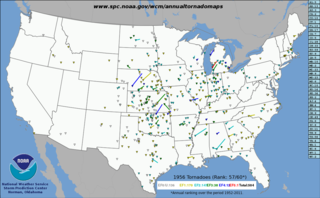
This page documents the tornadoes and tornado outbreaks of 1956, primarily in the United States. Most tornadoes form in the U.S., although some events may take place internationally. Tornado statistics for older years like this often appear significantly lower than modern years due to fewer reports or confirmed tornadoes.
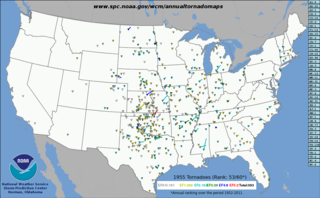
This page documents the tornadoes and tornado outbreaks of 1955, primarily in the United States. Most tornadoes form in the U.S., although some events may take place internationally. Tornado statistics for older years like this often appear significantly lower than modern years due to fewer reports or confirmed tornadoes.
Between April 23–30, 1961, a tornado outbreak sequence struck the Midwest, Ohio, and Mississippi Valleys, and the Eastern United States. Large hailstorms accompanied the tornadoes as well and numerous other weather events also occurred. Three people were killed, 38 others were injured and losses totaled $26.810 million. Two additional fatalities also occurred due to flooding and lightning.
This page documents the tornadoes and tornado outbreaks of 1946, primarily in the United States. Most recorded tornadoes form in the U.S., although some events may take place internationally. Tornado statistics for older years like this often appear significantly lower than modern years due to fewer reports or confirmed tornadoes.















